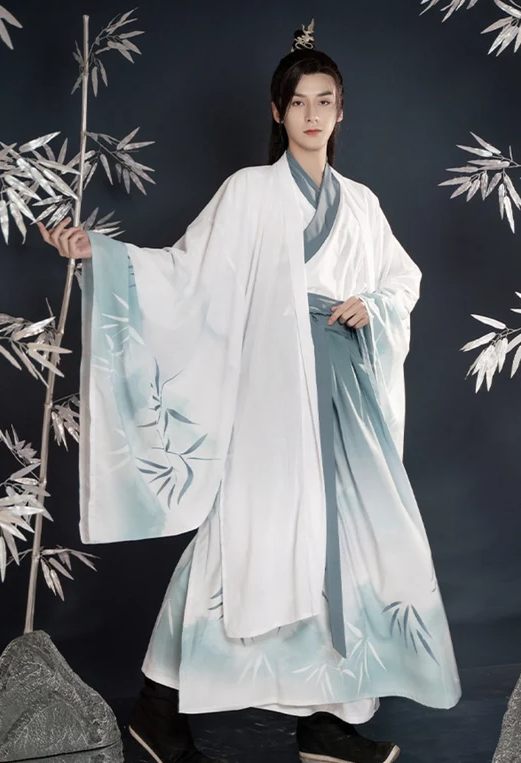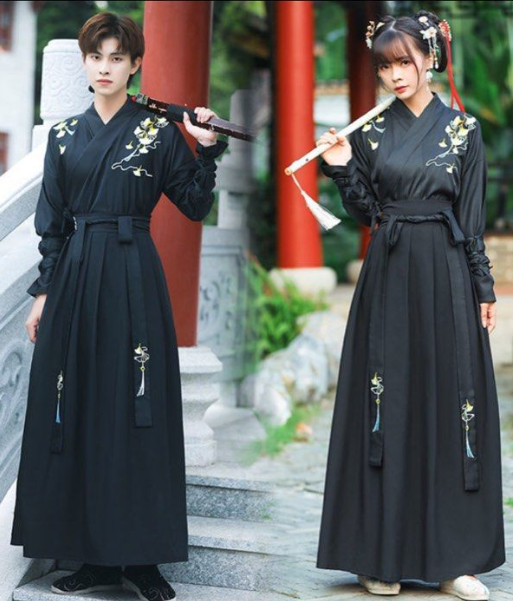Hanfu traditionally has gender-specific styles, but modern adaptations are increasingly embracing gender-neutral designs.
Understanding Gender Neutrality
Definition and Importance
Gender neutrality refers to the idea that social institutions, policies, languages, and other social constructs should avoid distinguishing roles based on people’s sex or gender. This concept aims to break down stereotypical gender roles that have historically marginalized or limited
on their perceived gender.
- Definition: At its core, gender neutrality emphasizes the equal treatment of individuals regardless of their gender or sex, seeking to eliminate biases based on these distinctions.
- Societal Importance: The adoption of a gender-neutral stance in society can lead to more inclusive environments, reduce prejudices, and foster equality.

Gender Neutrality in Fashion
Fashion, as an influential part of culture, has a significant role in reinforcing or challenging societal norms. Over the past few decades, the fashion industry has seen a shift towards more inclusive and gender-neutral designs.
- Early Instances: Historically, many cultures had clothing that was relatively unisex. However, as societies evolved, distinct gender roles and corresponding clothing became more pronounced.
- Modern Trends: Today, designers like Jaden Smith and brands like Gucci are blurring the lines with their collections, showcasing pieces that can be worn by any gender. This reflects a broader societal shift towards accepting and celebrating individuality.
- Impact on Consumers: With the rise of gender-neutral fashion, consumers have more freedom to express themselves without the constraints of traditional gender norms. This freedom not only offers more choices but also promotes acceptance and understanding among different communities.
Hanfu in Traditional Context
Male and Female Forms of Hanfu
Traditionally, Hanfu exhibits distinct styles and forms for males and females. For men, the clothing often consisted of a yi (a type of tunic that crosses the left part over the right) and a narrow, tapered, ankle-length pant. Women, on the other hand, frequently wore flowing robes and sometimes elaborate headpieces.
- Men’s Hanfu: The male versions often prioritized functionality and comfort, facilitating the ease of movement necessary for work or combat.
- Women’s Hanfu: Female hanfu traditionally emphasized aesthetics and intricate designs, often featuring embroidery, silks, and layers. The ruqun—a gown with a separate top and skirt—was a popular choice among women.
Social Significance
The way Hanfu dresses were made, decorated, and worn conveyed a lot about an individual’s social status and occupation in historical China. Officials and the elite would often wear more complex garments adorned with significant symbols and quality materials to distinguish themselves.
- Symbols and Patterns: Motifs like dragons, phoenixes, and other mythical creatures often appeared on the clothing of nobility, indicating their elevated status.
- Colors: Specific colors like red, yellow, or green were not just fashion choices but could signify rank, season, or even philosophical beliefs.
Cultural Interpretation
Hanfu isn’t just a style of clothing; it’s a significant cultural symbol. It reflects the aesthetic standards, philosophies, and social norms of traditional Chinese culture. For example, the “yi” in “yifu,” which means “clothes” in Chinese, stands for “justice,” signifying the traditional Chinese view that clothing is not just about covering the body but also about expressing internal virtues.
- Confucian Influence: Confucian ideals heavily influenced Hanfu designs. The formality of the garments aimed to reflect the wearer’s morality, social standing, and even their respect for society and its norms.
- Ceremonial Usage: Hanfu was often donned for traditional Chinese ceremonies, festivals, and scholarly pursuits, signifying its importance in various aspects of daily life beyond mere functionality.
Modern Adaptations of Hanfu
Hanfu Revival Movement
The Hanfu Revival Movement has gained momentum in the 21st century, primarily among young people who view the traditional dress as a symbol of Chinese culture and identity. This resurgence isn’t just about recreating historical costumes but also about adapting Hanfu to fit modern lifestyles.
- Role of Social Media: Platforms like Weibo and Instagram have played a crucial part in popularizing the Hanfu Revival Movement. Users share photos of themselves wearing Hanfu, often modernized to suit contemporary fashion sensibilities.
- Political and Social Aspects: While some see the Hanfu revival as a form of cultural reclamation, others argue that it can sometimes veer into the realm of nationalism. Regardless, the movement has reignited interest in traditional Chinese culture and aesthetics.
Contemporary Hanfu Styles
Modern Hanfu styles have significantly evolved to meet contemporary fashion norms while retaining elements of traditional design. Some designers are creating fusion styles, incorporating Western elements or making the garments more practical for everyday wear.
- Innovation in Fabric: Unlike traditional Hanfu, which predominantly used silk or hemp, modern versions incorporate a variety of fabrics, including cotton and synthetic materials, making them more accessible and comfortable.
- Unisex Styles: Some designers are even moving toward unisex Hanfu styles, challenging the traditional gender-specific norms associated with these garments.
Influence of Pop Culture
Pop culture, especially Chinese dramas and pop idols, has had a significant impact on the Hanfu Revival Movement. Famous actors wearing Hanfu in historical dramas or music videos often spark trends and inspire fans to explore this traditional fashion.
- Celebrity Endorsements: Popular figures endorsing or wearing Hanfu in public events have catapulted the attire back into mainstream fashion.
- Global Impact: Through pop culture, Hanfu has not only re-emerged in China but has also gained a following overseas. Elements of Hanfu design are increasingly being incorporated into broader fashion trends.
Gender Neutrality in Hanfu: Arguments For
Unisex Designs and Styles
One of the strongest arguments for the gender neutrality of Hanfu lies in the emergence of unisex designs. A growing number of Hanfu designers are creating styles that are suitable for all genders.
Contemporary Usage and Adaptations
Another point in favor of Hanfu’s gender neutrality is its contemporary usage and the flexibility in its design. Young people are donning Hanfu for a variety of events, from cultural festivals to casual daily wear, and they often choose to ignore traditional gender-specific norms.
- Daily Wear: In urban settings, it’s becoming more common to see people of all genders wearing Hanfu styles that were traditionally gender-specific, showing the adaptability of these garments.
- Inclusivity in Fashion Shows: Modern Hanfu fashion shows often feature models of all genders wearing a wide range of styles, breaking down traditional gender barriers in the process.
Social Media Influence
Social media platforms, notably Instagram and Weibo, have become battlegrounds for challenging traditional fashion norms, including those surrounding Hanfu. Influencers who wear gender-neutral or gender-flipping Hanfu styles have attracted large followings.
- User Generated Content: The rise in shared photos and videos of unisex or cross-gender Hanfu outfits creates an online culture that embraces gender fluidity.
- Viral Trends: Hashtags like #UnisexHanfu or #GenderNeutralHanfu are gaining popularity, which adds momentum to the argument for gender-neutral Hanfu styles.

Gender Neutrality in Hanfu: Arguments Against
Traditional Gender Roles and Significance
- Cultural Heritage: Many argue that the gender-specific aspects of Hanfu are an essential part of the Chinese cultural heritage and should be preserved. Altering these could be seen as a dilution of its cultural and historical significance.
- Symbolism: The distinct styles for men and women often carried deep symbolism and even philosophical connotations, informed by Confucian, Taoist, and Buddhist principles. To remove the gender specificity could mean losing these rich layers of meaning.
Lack of Unisex Forms in Historical Context
Another argument against the gender neutrality of Hanfu is the absence of unisex forms in its historical iterations. Unlike some other cultural garments that were designed to be worn by any gender, traditional Hanfu had clear distinctions.
- Historical Accuracy: Advocates for maintaining the gendered aspects of Hanfu often cite the importance of historical accuracy. They argue that introducing unisex styles would deviate from the authentic forms of these traditional garments.
- Archival Evidence: Extensive historical texts and visual records, such as paintings and sculptures, predominantly depict men and women in clearly differentiated Hanfu styles. This historical evidence adds weight to the argument against its gender-neutrality.